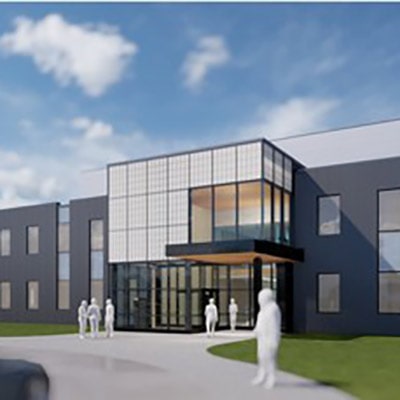
Modern Niagara Group has an ambitious goal for its retrofit of an industrial and office complex at 945 Princess St. In Kingston, Ont. The contractor is targeting an 80 per cent reduction in greenhouse gas (GHG) emissions at the 1940s-era structure.
Ottawa-based Modern Niagara has already started on the project, which was contracted out by the numbered Ontario company which owns the building. The property includes data centres and office space for tenants, which include Queen's University, SPARQ Systems and GreenCentre Canada.
Upgrades to the 220,000-square-foot building are designed to reduce carbon emissions by approximately 2,000 tonnes annually.
The approximately $50-million project is receiving $25 million in funding from the Canada Infrastructure Bank (CIB).
According to Andrew Creese, Modern Niagara's director of investments, the CIB's minimum GHG reductions threshold for similar projects is around 25 per cent. Setting an 80 per cent reduction target made the Princess St. project an attractive one for the CIB.
Drawing investors with sustainability
It will be achieved through measures such as replacing the building's existing fossil fuel-powered heating system with electrified heat pumps, as well as enhancing its operations control system and upgrading insulation.
Modern Niagara has started construction and aims to complete the project in 2024.
"I think you've got some investors in the property who are very eager to look at a facility that has significant potential, and really looking to revitalize the facility, with the goal of creating this premiere innovation centre," said Robert Montgomery, Modern Niagara's vice president of sales and lifecycle solutions.
"(We're) really looking at attracting organizations that are focused on sustainability and the development of sustainable technologies."
The building is owned by 2853913 Ontario Inc.
The road to retrofits
The project began about a year ago, with the initial conversations centering on which technologies would be most beneficial for the retrofit.
"We had to investigate a lot of technology so the timeline was interesting, because there was a lot of time at the start evaluating technologies to determine which ones had the best financial ROI (return on investment)," said Kevin Spencer, Modern Niagara's vice president of energy solutions. "There's also the environmental ROI, I'll call it."
For each aspect of the retrofit, Modern Niagara looked at the cost, how it would align with its carbon reduction objectives as well as the greenhouse gas reductions per dollar spent.
With a range of technologies available today for retrofits, Modern Niagara considered several options and ended up discarding two fairly common systems.
The first was geothermal, which Spencer said is due to the nature of a retrofit and because large manufacturing spaces don't lend themselves well to geothermal systems.
Modern Niagara also looked at implementing earth tubes — where long tubes are buried underground, retaining some of the ground heat in both the heating and cooling seasons. The impediment here was the amount of excavation that would've been required.
It also cast an eye to the future and the potential for further sustainable upgrades as technology improves. This led to the use of heat pumps, even though they require a backup source of heat for the colder winter months. Modern Niagara plans to use natural gas boilers as a supplement.
"When we have a tenant that comes in there and needs excessive amounts of fresh air from the outside, it's extremely expensive to heat that with heat pumps, or electric boilers, so we're going to supplement the process loads with natural gas today," Spencer explained. "The plan is to get off of that in the future as technology develops."
Tenants can also opt for renewable natural gas to further enhance sustainability.
The carbon reduction is primarily a result of getting the building off steam boilers. Those numbers were determined by Modern Niagara's in-house energy engineering team, but a third-party verification was also taken as part of the checks and balances for the CIB.
"This will probably be our most our most intense measurement and verification program from a retrofit perspective, where we are doing a measurement and verification process over a longer period of time and continually driving that energy intensity of the building down," Spencer said.
The CIB funding
Through its Building Retrofits Initiative, the CIB has committed more than $800 million toward similar retrofits. The organization seeks to invest up to $5 billion into green infrastructure.
"Not only will this partnership with Modern Niagara result in significant carbon reductions, it will also advance the creation of an innovation hub in Kingston which will attract jobs and prominent tenants to the community for years to come," Ehren Cory, the CIB's CEO said in a statement on the retrofit.
The building operator will have to recertify that it is continuing to generate those energy savings for the building on an annual basis in order to maintain the funding. If it falls into default, the remaining portion of the loan must be repaid.
"In an ideal world, every project they fund is going to be a net-zero project. Reality is, is that's not possible and in many cases, for a variety of reasons," Creese said. "But taking 2,000 tonnes of GHG off out of the atmosphere . . . they're pretty keen to be able to be part of that and help fund and support that financially."










